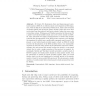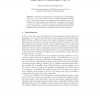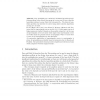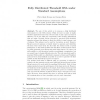ASIACRYPT
2001
Springer
15 years 5 months ago
2001
Springer
The Advanced Encryption Standard (AES) provides three levels of security: 128, 192, and 256 bits. Given a desired level of security for the AES, this paper discusses matching publi...
ASIACRYPT
2001
Springer
15 years 5 months ago
2001
Springer
Abstract. At Crypto ’88, Matsumoto, Kato and Imai proposed a protocol, known as RSA-S1, in which a smart card computes an RSA signature, with the help of an untrusted powerful se...
ASIACRYPT
2001
Springer
15 years 5 months ago
2001
Springer
With chosen-IV chosen texts, David Wagner has analyzed the multiple modes of operation proposed by Eli Biham in FSE’98. However, his method is too unrealistic. We use only known-...
ASIACRYPT
2001
Springer
15 years 5 months ago
2001
Springer
Abstract. We give a careful, fixed-size parameter analysis of a standard [1,4] way to form a pseudorandom generator by iterating a one-way function and then pseudo-random function...
100
click to vote
ASIACRYPT
2001
Springer
15 years 5 months ago
2001
Springer
Within the security architecture of the 3GPP system there is a standardised encryption mode f8 based on the block cipher KASUMI. In this work we examine the pseudorandomness of the...
ASIACRYPT
2001
Springer
15 years 5 months ago
2001
Springer
100
click to vote
ASIACRYPT
2001
Springer
15 years 5 months ago
2001
Springer
We present an algorithm for counting points on superelliptic curves yr = f(x) over a finite field Fq of small characteristic different from r. This is an extension of an algorit...
115
Voted
ASIACRYPT
2001
Springer
15 years 5 months ago
2001
Springer
Abstract. Frey and R¨uck gave a method to transform the discrete logarithm problem in the divisor class group of a curve over Fq into a discrete logarithm problem in some finite ...
116
click to vote
ASIACRYPT
2001
Springer
15 years 5 months ago
2001
Springer
The aim of this article is to propose a fully distributed environment for the RSA scheme. What we have in mind is highly sensitive applications and even if we are ready to pay a pr...
ASIACRYPT
2001
Springer
15 years 5 months ago
2001
Springer
Abstract. Semantic security against chosen-ciphertext attacks (INDCCA) is widely believed as the correct security level for public-key encryption scheme. On the other hand, it is o...




